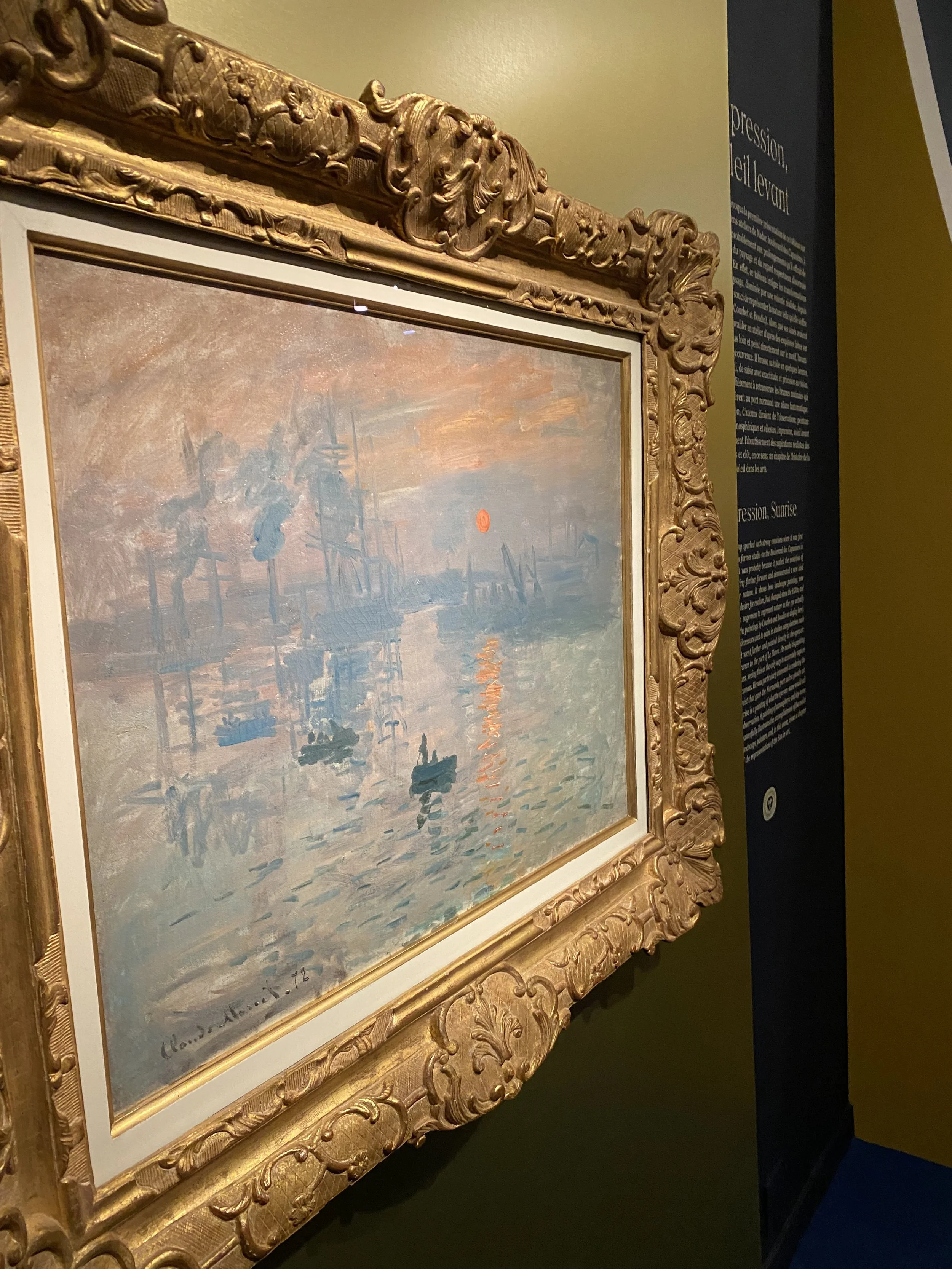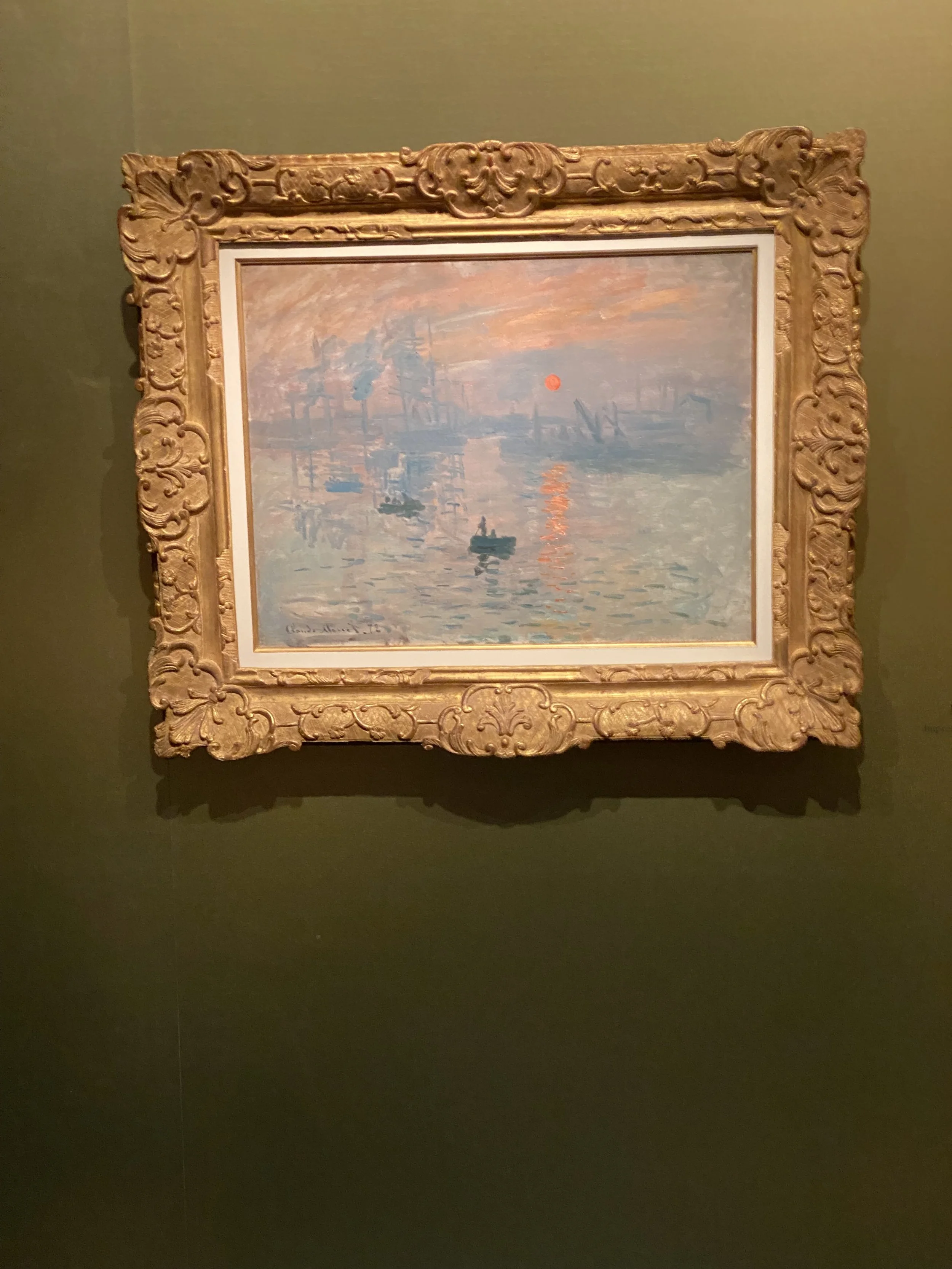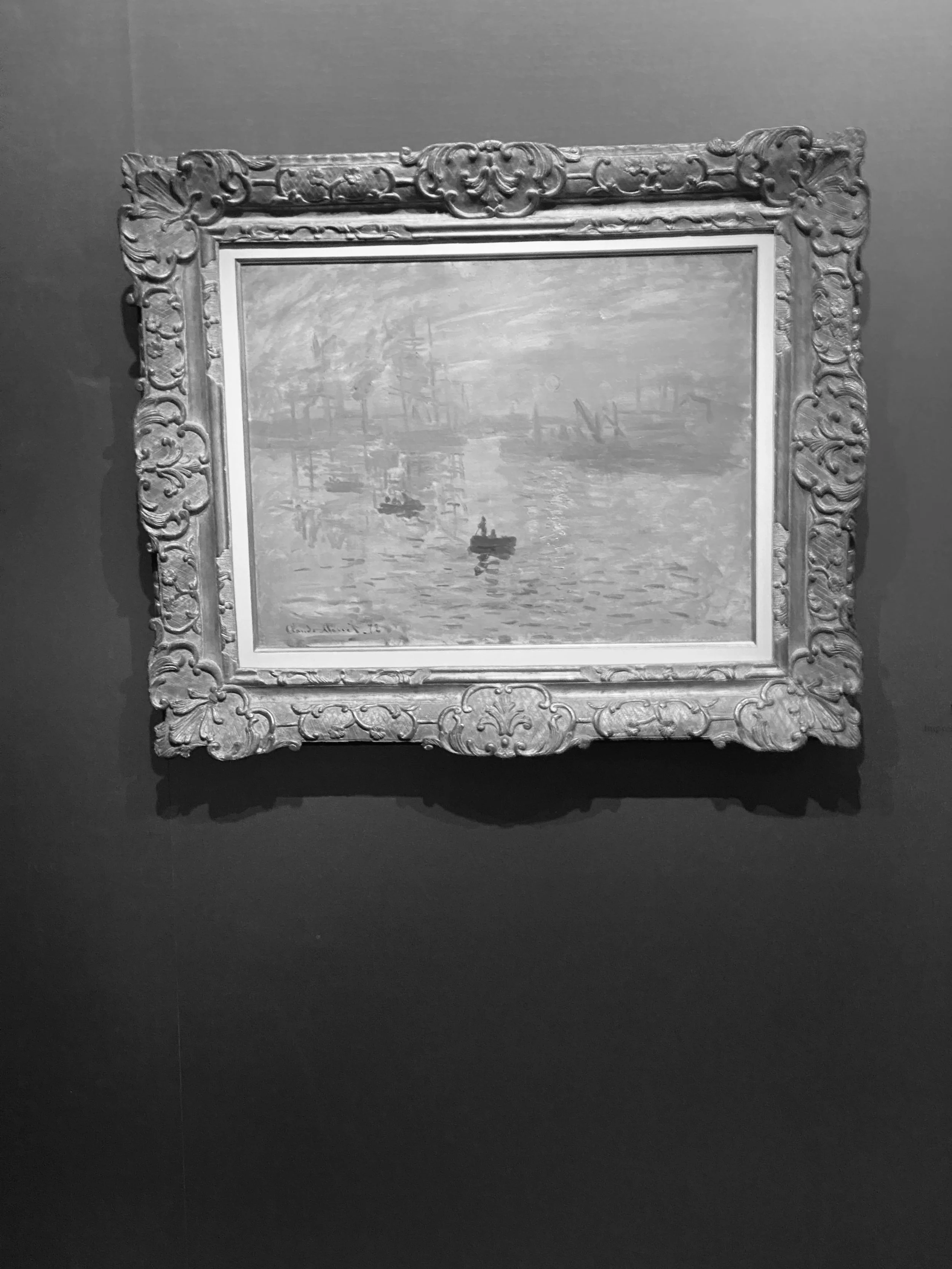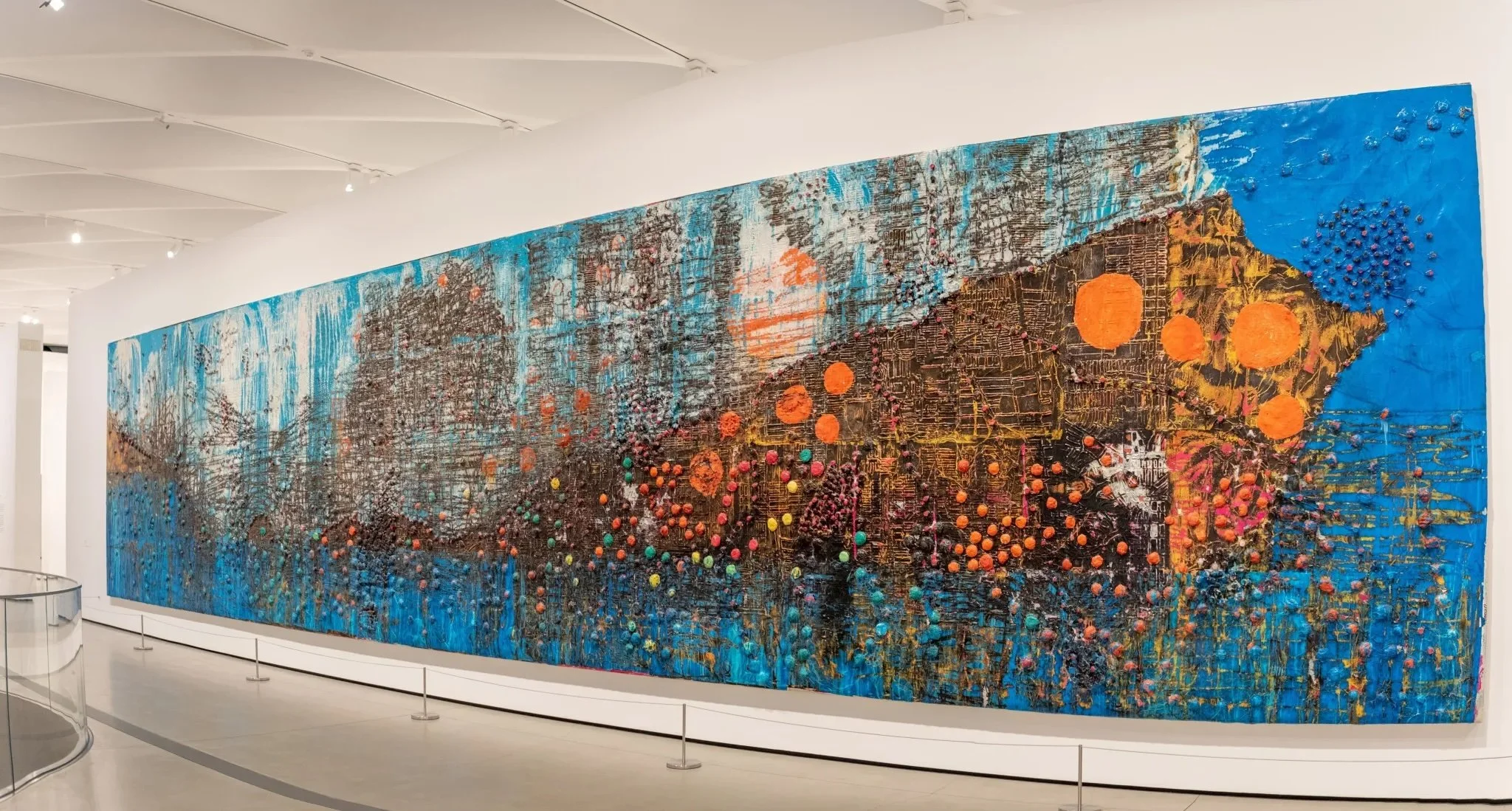At the Edge of Seeing: Technique, Affect, and the Physiology of Painting
Monet, Impression Sunrise. One paradigm for more informed studio practice
Can technique shape creative studio practice—and to what degree should it? It is a question that lies at the heart of painting, and one that every generation must ask again. For all our desire for originality, painters remain bound by shared materials, inherited methods, and the physiological limits of human sight. What seems most personal in art often emerges from what is most universal.
Nowhere is that paradox clearer than in the study of equiluminance: the deliberate balancing of colours of equal brightness to induce optical instability. This phenomenon, famously exploited in Monet’s Impression, Sunrise (1872), shows how informed technique shapes visual outcome—and how outcome, in turn, reshapes artistic intent. It is a circular navigation between the painter’s will and the medium’s agency, between material knowledge and perceptual discovery.
There is a moment in front of certain paintings when looking stops being an act of recognition and becomes a kind of physiological experience. Vision itself seems to take precedence over thought, as if perception were occurring before the mind has quite caught up. Monet’s Impression, Sunrise is one of those works. Its orange sun, hovering in the hazy blue-grey harbour of Le Havre, appears to pulse and shimmer as if alive. Yet what we are experiencing is not the motion of light but the motion of the visual system itself—an encounter between pigment and perception that dissolves the border between technical procedure and emotional affect.
Ordinarily, we consume images through the mind’s eye: the cognitive apparatus that translates visual information into meaning, what neuroscience later termed the ventral or “what” pathway, responsible for identifying and classifying what we see. But painting can bypass that interpretive channel. Dr Margaret Livingstone of Harvard University has shown that perception is not a single process but the result of multiple neural pathways that interact—and sometimes conflict—with one another.¹ The ventral or “what” stream specialises in object recognition and colour discrimination, whereas the dorsal or “where” stream governs motion, depth, and spatial awareness. When an image contains equal-luminance colour contrasts—as Monet’s sun does—the “where” system is starved of the luminance cues it relies on to stabilise form. The brain, deprived of a clear signal, allows the chromatic “what” system to dominate, producing a perceptual instability: the orange disc seems to float, the boundaries of form dissolve, and the act of seeing becomes bodily rather than cognitive.
Livingstone terms this phenomenon equiluminance—a condition in which colours of equal brightness but different wavelengths set the visual system into conflict.² The magnocellular (luminance-sensitive) pathway cannot detect motion or depth, while the parvocellular (colour-sensitive) pathway continues to supply chromatic data. The viewer’s perception flickers between them. What we read as shimmer or vibration is not a property of the painting itself but of our own neurological architecture under strain. Monet’s manipulation of value thus activates the nervous system directly, bypassing intellect and emotion alike to engage the physiological substrate of perception.
This is the point at which a painter’s technē—the informed, material decision-making within process—meets affect, the bodily charge of sensation. Affect refers here to what a painting does rather than what it depicts: the visceral, pre-cognitive response it elicits in the viewer. Effect, by contrast, denotes the result or outcome of that affective charge, often shaped by interpretation or meaning. Affect is immediate and bodily; effect is reflective and mental. The painter’s concern, particularly in the lineage from Monet to contemporary practice, lies primarily in the former: not what an image means, but what it does to the eye.
Such discoveries were not accidental. The nineteenth century saw painters become de facto scientists of perception. Michel-Eugène Chevreul’s De la loi du contraste simultané des couleurs (1839) codified the relationship between adjacent hues, explaining how complementary colours intensify each other when juxtaposed.³ Chevreul’s diagrams—concentric wheels of chromatic opposition—became studio bibles. Monet, Pissarro, and Seurat each absorbed his findings, translating them into pigment. Yet what distinguishes Impression, Sunrise from the more systematic optical experiments of Seurat is its balance between empirical method and intuitive handling. Seurat sought optical clarity through divisionism—small, regular dots designed to fuse in the eye of the beholder—whereas Monet pursued perceptual ambiguity. The brushwork does not prescribe how we should see; it offers the experience of seeing itself. In Impression, Sunrise, technique becomes transparent to affect: the artist’s informed manipulation of hue and value (their technē) generates a physiological reaction (our affect), which in turn produces an emotional effect—the feeling of light emerging through mist.
Monet’s process was not naïve but rigorously experimental. Letters reveal an awareness of both optical and material causes of luminosity: that warm pigments advance and cool pigments recede, that adjacent complements increase saturation, and that broken colour prevents tonal deadness. Yet the triumph of Sunrise lies not in its adherence to theory but in its subversion of it. Chevreul’s system promised harmony; Monet discovered instability. The painting’s power arises from being poised on the knife-edge between knowledge and sensation—a borderland where technique ceases to illustrate science and begins to embody experience.
Livingstone’s research, more than a century later, reframes Monet’s intuitions in scientific language. She notes that many artists have exploited equiluminant contrasts—Matisse in The Red Studio, Rothko in his late floating fields, and even Op artists like Bridget Riley—to evoke the impression of motion or depth.⁴ But Monet’s use is subtler and more integrated. The orange sun and its reflections share nearly the same luminance as the surrounding sky and water. Consequently, the magnocellular system, responsible for detecting form through luminance, loses track of the sun’s edges. The viewer’s gaze cannot rest; the sun seems to detach from the picture plane and hover in front of it. Here the affect of vibration is inseparable from the technique that produces it. The wet-in-wet brushwork further blurs boundaries between figure and ground, enhancing perceptual ambiguity. Each quick, calligraphic stroke—neither solid nor transparent—denies visual rest. The entire surface becomes a field of micro-fluctuations.
To a contemporary painter, the lesson is clear: affect is built, not bestowed. The emotive charge of a painting does not arise despite its material construction but because of it. When pigments of equal luminance interact, they engage the architecture of the eye itself; the painting becomes an instrument played upon the nervous system. The painter’s task, in such moments, is to tune the instrument—to adjust hue, value, and edge until sensation and meaning coincide.
It is tempting to imagine such discoveries as breakthroughs, but in reality they are recursive. Every technical innovation in painting is both a return and an extension. Monet’s concern with colour interaction can be traced through Delacroix’s broken tones, Turner’s atmospheric veils, and ultimately to the Venetian painters who understood that light is not added to colour but released from it.
The Impressionists did not abandon tradition; they re-routed it through the eye of modern science. This iterative process exemplifies technē in its classical sense. The Greek term does not simply mean “technique” but connotes a mode of knowing through making—knowledge embodied in action. As Heidegger later observed, technē is both art and craft, a revealing (poiesis) of what lies hidden in materials.⁵ To paint with awareness of how colour and luminance co-produce perception is to participate in that lineage: to make not only with the hand but with understanding. In this sense, Impression, Sunrise stands as a paradigm of informed making. The aim is not to copy nature but to reconstruct its perceptual equivalent. The painting is less an image of a sunrise than an experiment in what “sunrise” feels like to the visual cortex. Technique and affect converge in a single act of technē—deliberate, iterative, and empirically grounded, yet ultimately in service of sensation.
For contemporary painters, the question is how to inherit this dual consciousness: to command technique without being confined by it, and to harness affect without descending into spectacle. In an age of retinal overload—digital screens, saturated advertising, algorithmic colour grading—the challenge is not to excite the eye but to recalibrate it. Many painters now work at this liminal border through the deliberate shaping of material process. Consider, for example, the current revival of optical neutrality—the use of near-equiluminant layers to produce atmospheric depth. When a surface is constructed so that hue changes faster than value, the viewer experiences subtle instability, a sense of the image breathing. Similarly, the alternation of opaque and translucent layers can produce physiological depth through micro-refractions of light, independent of illusionistic space. Painters such as Mark Bradford or Julie Mehretu manipulate these effects at monumental scale, layering pigments, polymers, and collage elements to produce visual flicker and motion. Their work engages the body of the viewer not through narrative but through sensory overload: the painting as field of affect. Even in quieter contemporary practices—the diffused chromatic atmospheres of Idris Khan or the pearlescent veils of Sean Scully’s recent Landline series—the dialogue between controlled process and embodied perception persists. What unites these approaches with Monet’s is the recognition that sensation is not spontaneous but constructed. Just as musicians tune instruments to evoke particular harmonics, painters tune materials to evoke perceptual resonance. The process is technical, but the outcome is emotional.
At this juncture it becomes useful to distinguish between affect—the painting’s capacity to move or disturb—and intent, the painter’s purpose in constructing that capacity. Technique without intent risks degenerating into mannerism; affect without technique risks sentimentality.
Affect without technique risks sentimentality because it lacks the mediating structure through which feeling becomes form. To move another through painting requires more than sincerity of emotion; it requires the technical means to give that emotion perceptual presence. Without that discipline, affect collapses into illustration—a direct appeal to empathy rather than an orchestration of perception. The viewer is told what to feel rather than invited to discover feeling through the experience of seeing. Technique, in this sense, is not a barrier to emotion but its conduit. It translates impulse into visual language. When emotion is expressed without sufficient craft—without understanding how colour, composition, value, or surface condition shape the body’s response—the result is often sentimentality: a kind of emotional overstatement that seeks validation rather than engagement.
By contrast, when affect is shaped by technē—when the painter understands how perception can be activated through hue, value, rhythm, or edge—the emotional resonance arises organically. The painting does not say “this is sad” or “this is ecstatic”; it feels so in its construction. The distinction is subtle but crucial: sentimentality is declared feeling, whereas affect is discovered feeling. The former tells; the latter reveals. As Johnny Golding has observed in lectures at the Royal College of Art, colour is not a descriptor but an event—“matter thinking itself,” a form of intelligence that precedes language. When a painter works through colour rather than upon it, affect is not applied to the surface but generated within it. Feeling emerges not as commentary but as consequence: the painting begins to think sensorially, its chromatic relations enacting a form of embodied reasoning. In this way, colour becomes the bridge between perception and emotion—the site where material process turns into experience.
Golding’s conception of colour as a universal intelligence—an event through which matter becomes sensate—might seem far removed from Monet’s empiricism, in which colour operates as measurable wavelength and optical data. Yet these are not incompatible truths but complementary revelations of the same mystery. Where Golding approaches colour as ontology, Monet approaches it as method; one speaks of becoming, the other of making. But both recognise that colour exceeds description—that it thinks, acts, and feels before it signifies. In Golding’s terms, colour is the pulse of being; in Monet’s, it is the pulse of perception.
This duality is not a contradiction but the condition of painting itself. The painter stands precisely between these two truths: the universal and the empirical, the felt and the observed, the metaphysical and the material. To paint is to navigate that interval—to turn matter into thought and thought back into matter. If Golding reminds us that colour is an intelligence older than words, Monet reminds us that it is also an experiment reproducible in pigment. Between them lies the essence of technē: knowledge embodied as action, where universality finds expression through craft.
Painting’s enduring truth may be this: that its power resides not in choosing between dualities but in sustaining them—in holding together the seen and the felt, the optical and the ontological, the measurable and the ineffable. Every act of painting is therefore a negotiation between knowing and becoming, an empirical inquiry that opens onto mystery. In that sense, the duality between Golding and Monet is not a division but a mirror, reflecting the painter’s own task: to make the universal particular, and the particular universal, through the language of colour.
References
Chevreul, Michel-Eugène. De la loi du contraste simultané des couleurs. Paris, 1839.
Golding, Johnny. Lectures on Colour and Material Thinking, Royal College of Art, London.
Greenberg, Clement. Art and Culture: Critical Essays. Boston, 1961.
Heidegger, Martin. The Question Concerning Technology and Other Essays. Trans. William Lovitt. New York, 1977.
Livingstone, Margaret. Vision and Art: The Biology of Seeing. New York, 2002.




